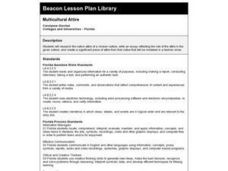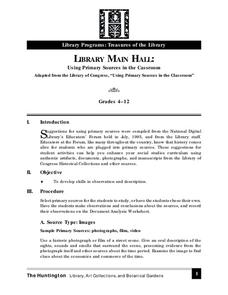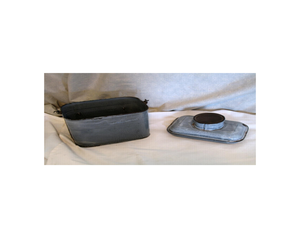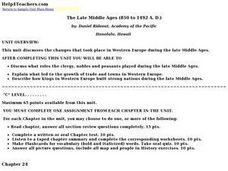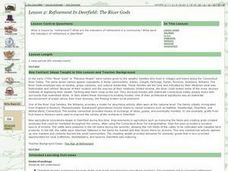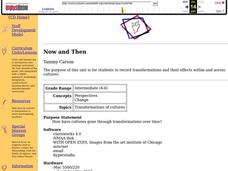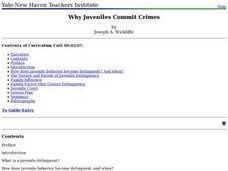Oxfam
Sweatshops - Exploitation Is Never in Fashion
Here's a resource that brings home the idea that we are all part of a global community, that our actions have far reaching consequences. Class members examine the labels in their clothes, create a list of the manufacturers, the countries...
Curated OER
Victorian Fashion Detectives
A rare lesson plan on fashions that were in vogue during the Victorian era. Learners discover what types of clothes both rich and poor people of this time period wore. They see how fashions changed during the reign of Queen Victoria, and...
Curated OER
ARTSEDGE: Creating Costumes
Young designers examine famous monarch portraits and costume books, create a design for the emperor, examine fabric samples and choose a type and color for their costume. They sketch the costume and present it in a class fashion show.
Curated OER
First Lady Fashions
Sixth graders research and explore the fashion of a certain time while identifying with the personal convictions and tastes of the famous first ladies of the past. They practice what they explore adjectives to describe what they see and...
Curated OER
Multicultural Attire
Students research the native attire of a chosen culture, write an essay reflecting the role of the attire in the given culture, and create a significant piece of attire from that culture that be modeled in a fashion show.
Curated OER
Skinny Models
Young scholars read a newspaper article about a fashion show in Madrid which banned the use of models under a certain weight. They define vocabulary, complete comprehension worksheets, practice the use of the words 'enough' and 'too...
Curated OER
1950’s American Culture: Television, Fashion, and Music
Sixth graders investigate the impact of popular culture on Americans. In this 1950's America lesson, 6th graders view television clips, listen to audio clips, and look over fashion photographs from the decade. Students then discuss...
Curated OER
Vocational: Fashion terms
Students view a Powerpoint presentation on fashion industry vocabulary and locate examples in magazines that illustrate the terms. On black construction paper, students assemble collages of the magazine pictures representing each of the...
Curated OER
Shoes: Practical vs. Fashionable
Students compare and contrast the difference between practical applications of apparel and the use of fashion as a status symbol, with a focus on shoes. Working in groups, they complete a Venn diagram comparing practical fashion to...
Curated OER
Using Primary Sources in the Classroom
Scholars study a historical photograph to make predictions of what happened right after the picture was taken. They research a variety of different topics and use primary sources to answer questions about common food, fashion trends, and...
Curated OER
Clothing-Based Bias
Students investigate stereotypes attached to clothing. In this teaching tolerance lesson students explore how the way someone dresses can influence other people's perception of that person. Students discuss what groups of people might be...
Curated OER
Lunch Pail
Explore a 1900s lunch pail. In this oral language and 1900s history lesson, students view a photograph of an old-fashioned lunch pail. Students describe the object and make predictions about what it is and its possible uses. Students...
Curated OER
Becoming a Member of an 1830s Family
Students compare and constrast life in an 1830s family verses a modern family. They role play the position of a family member in 1830 while wearing traditional clothing for the time period. They write journal entries to show their daily...
Curated OER
The "Me" Decade: 1970
Pupils view the video on Mary Tyler Moore Show. They discuss what they notice about the treatment of Mary Tyler Moore's character in the show. Students listen to a lecture covering notes on web diagram, such as: Fads, fashion, the New...
Curated OER
The Late Middle Ages (850 to 1492 A. D.)
Learners discuss what roles the clergy, nobles and peasants played during the late Middle Ages. They explain what led to the growth of trade and towns in Western Europe. Ultimately, students describe how kings in Western Europe built...
Curated OER
Lemonade Stand: Making Money the Old-Fashioned Way
Young scholars run their own lemonade stand and are to figure out what to sell the lemonade at to gain the maximum profit.
Curated OER
Historical Witness - social Messaging
Students examine and develop artwork that shows women's roles during different eras. In this women's role lesson, students look at artwork that shows women at work during the mid-nineteenth to early twentieth century. They design a mixed...
Curated OER
Refinement in Deerfield: The River Gods
Students research the town of Deerfield, CT and its River God families to show how the middle class developed in the Connecticut River Valley.
Curated OER
You Are What You Wear
Learners, after analyzing interactions between groups/societies, effects of causality/change over time, forms of imaginative writing and utilizing art media to conveying messages/meaning, examine the relationship between clothing and...
Curated OER
Now and Then
Students record transformations and their effects within and across cultures. Students study the life of specific people in a former time period and then in the present time period. This teacher focused on the Winnebago tribe, using her...
Channel Islands Film
Lone Woman of San Nicolas Island: Lesson Plan 4
Imagine being stranded all alone on an island for 18 years. How would you survive? Class members are challenged to makes necessities out of natural materials that would likely be found on an island.
Curated OER
Rock n' Rollin in the '50s
Students explore the culture of the United States in the 1950's. In this history lesson, students research culture in the 1950's, with a focus on fashion, music, television, automobiles, etc., then work in groups to create a...
Curated OER
Diggin' The Past
Learners explore the culture of Ancient Egypt. In this ancient civilizations lesson plan, students are divided into groups to research how aspects of culture were influenced by the Nile River. Learners create a slide show that describes...
Curated OER
Why Juveniles Commit Crimes
Students examine the reasons why juveniles commit crimes. As a class, they watch movies showing juveniles committing crims and discuss the impact on societies. They take a field trip to adult and juvenile courts and compare their...




